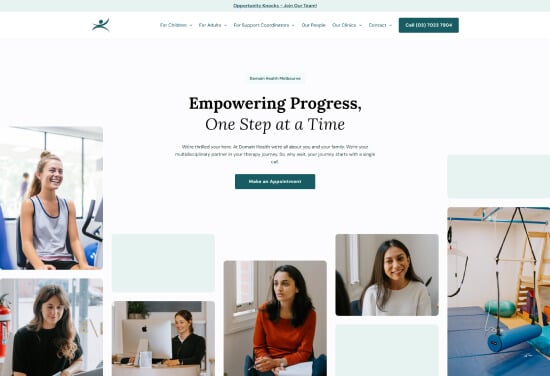

7 Essential Elements for Designing the Perfect NDIS Website

As Seen On
Are you an NDIS provider looking to create a website that effectively reaches and serves your target audience? In today’s digital age, having a well-designed website is crucial for attracting potential clients and showcasing your services. But what exactly makes an NDIS website “perfect”?
In this comprehensive guide, I’ll walk you through the 7 essential elements that every top-performing NDIS website should have. From user-friendly navigation to compelling content, I’ll cover everything you need to know to create a website that not only looks great but also drives results for your business.
TL;DR:
To design the perfect NDIS website, focus on creating a user-friendly, informative, and engaging online presence. Key elements include clear navigation, compelling content, strong calls-to-action, mobile responsiveness, accessibility features, social proof, and prominent contact information. By prioritizing these aspects and demonstrating your expertise, you can attract and convert more potential clients for your NDIS services.

Clear and Intuitive Navigation
- Your website’s navigation is the backbone of the user experience. Make it easy for visitors to find what they’re looking for with a clear and logical menu structure.
- Use descriptive labels for your menu items, such as “Our Services,” “About Us,” and “Contact.” Avoid jargon or confusing terminology.
- Implement a search function to help users quickly locate specific information.
- Ensure your navigation is consistent across all pages and devices.
Compelling and Informative Content
- Your website’s content should be engaging, informative, and tailored to your target audience’s needs and preferences.
- Use clear, concise language and break up text with subheadings, bullet points, and images to improve readability.
- Showcase your expertise by providing valuable resources, such as blog posts, case studies, and FAQs.
- Optimize your content for search engines by incorporating relevant keywords naturally throughout your text.
- As an NDIS provider, it’s crucial to convey empathy, professionalism, and a deep understanding of the challenges faced by individuals with disabilities and their families.
Strong Calls-to-Action (CTAs)
- Guide visitors towards taking desired actions, such as contacting your organization or requesting more information, with prominent and compelling CTAs.
- Use action-oriented language, such as “Get Started” or “Schedule a Consultation,” to encourage clicks.
- Place CTAs strategically throughout your website, such as above the fold on your homepage and at the end of blog posts.
- Ensure your CTAs stand out visually by using contrasting colors and ample white space.
Mobile Responsiveness
- With more and more people accessing the internet via smartphones and tablets, it’s essential that your NDIS website is optimized for mobile devices.
- Implement a responsive design that automatically adjusts to different screen sizes and orientations.
- Ensure your text is legible and your buttons are easy to tap on smaller screens.
- Test your website on various devices to ensure a seamless user experience across the board.
Accessibility Features
- As an NDIS provider, it’s especially important that your website is accessible to individuals with disabilities.
- Implement features such as alt text for images, keyboard navigation, and adequate color contrast to ensure your content is accessible to users with visual impairments.
- Provide closed captions for videos and transcripts for audio content.
- Follow Web Content Accessibility Guidelines (WCAG) to ensure your site meets industry standards for accessibility.
Social Proof and Testimonials
- Build trust and credibility with potential clients by showcasing social proof and testimonials on your website.
- Include quotes from satisfied clients, along with their photos and names (with permission).
- Display logos of any relevant certifications, awards, or partnerships your organization has earned.
- Incorporate customer reviews and ratings from third-party sites, such as Google or Facebook.
Prominent Contact Information
- Make it easy for potential clients to get in touch with your organization by displaying your contact information prominently throughout your website.
- Include a dedicated “Contact Us” page with your phone number, email address, physical address, and a contact form.
- Display your contact details in the header or footer of every page.
- Provide links to your social media profiles to give visitors additional ways to connect with your organization.
Avoid Generic Stock Photography
- While it may be tempting to rely on stock imagery to quickly populate your website, generic photos can actually undermine your credibility and authenticity.
- Instead of using obvious stock photos, invest in high-quality, original photography that showcases your organization, staff, and clients (with permission).
- Authentic visuals help build trust and create a more personal connection with your website visitors.
- If original photography isn’t feasible, opt for more unique, candid-style stock images that align with your brand and messaging.
- Remember, the goal is to use imagery that feels genuine and relatable to your target audience, rather than generic or staged photos that could apply to any website.
Summing Up
Designing the perfect NDIS website requires careful consideration of key elements such as navigation, content, CTAs, mobile responsiveness, accessibility, social proof, and contact information. By prioritizing these aspects and focusing on creating a user-friendly and informative online presence, you can effectively showcase your expertise and attract potential clients to your NDIS services.
Remember, your website is often the first point of contact between your organization and individuals seeking NDIS support. By implementing the strategies outlined in this guide, you can create a website that not only looks great but also effectively communicates your value proposition and drives meaningful results for your business.
FAQs
How often should I update my NDIS website’s content?
It’s important to regularly update your website with fresh, relevant content to keep visitors engaged and demonstrate your ongoing commitment to providing valuable information.
Aim to publish new blog posts, case studies, or resources at least once a month, and review your existing content quarterly to ensure it remains accurate and up-to-date.
How can I make my NDIS website more accessible?
Start by following WCAG guidelines and implementing features such as alt text, keyboard navigation, and sufficient color contrast.
Conduct regular accessibility audits using tools like WAVE or aXe to identify and address any barriers to access.
Engage with individuals with disabilities and seek their feedback on your website’s accessibility and user experience.
What if I don’t have any client testimonials or social proof yet?
If you’re a new NDIS provider, you may not have a wealth of client testimonials or social proof to display on your website. That’s okay!
Focus on showcasing your expertise and commitment to providing quality services through informative blog posts, detailed service descriptions, and a compelling “About Us” page.
As you begin working with clients, be sure to request feedback and testimonials that you can later incorporate into your website.
Final Thoughts:
Creating a top-performing NDIS website is an ongoing process that requires continuous refinement and optimization. By staying attuned to the needs and preferences of your target audience and regularly updating your site with valuable content and features, you can establish your organization as a trusted and authoritative resource in the NDIS space.
Remember, the ultimate goal of your website is to connect with and serve individuals with disabilities and their families. By prioritizing their needs and experiences at every stage of the design process, you can create a website that not only looks great but also makes a meaningful difference in the lives of those you support.
Casey Jones
Up until working with Casey, we had only had poor to mediocre experiences outsourcing work to agencies. Casey & the team at CJ&CO are the exception to the rule.
Communication was beyond great, his understanding of our vision was phenomenal, and instead of needing babysitting like the other agencies we worked with, he was not only completely dependable but also gave us sound suggestions on how to get better results, at the risk of us not needing him for the initial job we requested (absolute gem).
This has truly been the first time we worked with someone outside of our business that quickly grasped our vision, and that I could completely forget about and would still deliver above expectations.
I honestly can't wait to work in many more projects together!
Disclaimer
*The information this blog provides is for general informational purposes only and is not intended as financial or professional advice. The information may not reflect current developments and may be changed or updated without notice. Any opinions expressed on this blog are the author’s own and do not necessarily reflect the views of the author’s employer or any other organization. You should not act or rely on any information contained in this blog without first seeking the advice of a professional. No representation or warranty, express or implied, is made as to the accuracy or completeness of the information contained in this blog. The author and affiliated parties assume no liability for any errors or omissions.

